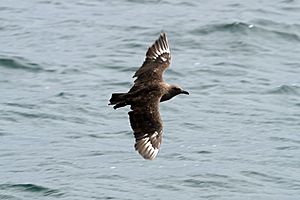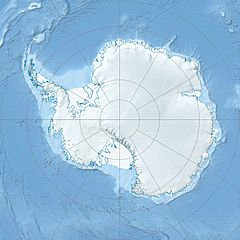Ryder Bay Islands Important Bird Area facts for kids
The Ryder Bay Islands Important Bird Area is a special place in Antarctica. It covers about 520 hectares (that's like 1,285 football fields!). This area is on the southeast coast of Adelaide Island. It's called an Important Bird Area (IBA) by BirdLife International. This means it's super important for birds. Many seabirds come here to build nests and raise their young. One of the main birds found here is the south polar skua. This special area includes the Léonie Islands and Rothera Point. These spots are at the entrance of Ryder Bay.
About Ryder Bay and Its Islands
Ryder Bay is a large bay that cuts into the coast of Antarctica. It is about 11 kilometers wide at its opening. The bay stretches 7 kilometers inland. It is located near Mount Gaudry. Explorers first found and mapped this bay and its islands in 1909. This was done by the French Antarctic Expedition. Later, other expeditions also explored and mapped the area. The bay is named after Lisle C.D. Ryder. He was part of an expedition in the 1930s.
The Léonie Islands are a group of small islands. They are located right at the mouth of Ryder Bay. The biggest island is Léonie Island. It is about 2 kilometers wide and 500 meters high. This island has a permanent icecap. Most of the islands in this bird area have patches of snow. But they also have rocky parts. These rocky areas have beaches, steep cliffs, and many rocks. These spots are free of ice. They are perfect for seabirds to build their nests. There are also small freshwater ponds and streams. The plants here are mostly lichens and mosses.
Rothera Point is a rocky headland. It was named in 1960 after John M. Rothera. He was a surveyor who worked in Antarctica. Rothera Point is a protected area. It is called Antarctic Specially Protected Area (ASPA) No.129. This protection helps scientists study the wildlife here. It also helps them check how human activities might affect the environment. This area is like a natural laboratory.
Amazing Animals of Ryder Bay
Rothera Point and the islands in Ryder Bay are home to many birds. In 2018, scientists counted 978 nests of south polar skuas here. These birds are a type of seabird. They are known for being strong flyers.
Other birds that live and breed in this important area include:
- Antarctic shags
- Wilson's storm petrels
- Antarctic terns
- kelp gulls
Besides birds, you can also see different types of seals here. They come to rest on the land or on floating ice during the summer. These seals include:
This area is a vital home for many Antarctic animals. It helps protect them and their breeding grounds.



